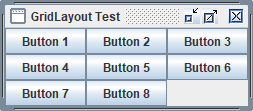

The GridLayout class has two constructors:
public GridLayout(int rows, int columns)
public GridLayout(int rows, int columns, int horizontalGap, int verticalGap)
GridLayoutTest.javaimport java.awt.GridLayout;
import javax.swing.JButton;
import javax.swing.JFrame;
public class GridLayoutTest {
public static void main(String[] args) {
JFrame.setDefaultLookAndFeelDecorated(true);
JFrame frame = new JFrame("GridLayout Test");
frame.setDefaultCloseOperation(JFrame.EXIT_ON_CLOSE);
frame.setLayout(new GridLayout(3,2));
frame.add(new JButton("Button 1"));
frame.add(new JButton("Button 2"));
frame.add(new JButton("Button 3"));
frame.add(new JButton("Button 4"));
frame.add(new JButton("Button 5"));
frame.add(new JButton("Button 6"));
frame.add(new JButton("Button 7"));
frame.add(new JButton("Button 8"));
frame.pack();
frame.setVisible(true);
}
}
Maintained by John Loomis, updated Thu Mar 26 15:28:00 2020